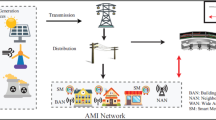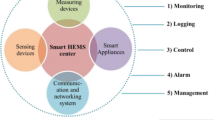Abstract
The next generation electrical power grid, known as smart grid (SG), requires a communication infrastructure to gather generated data by smart sensors and household appliances. Depending on the quality of service (QoS) requirements, this data is classified into event-driven (ED) and fixed-scheduling (FS) traffics and is buffered in separated queues in smart meters. Due to the operational importance of ED traffic, it is time sensitive in which the packets should be transmitted within a given maximum latency. In this paper, considering QoS requirements of ED and FS traffics, we propose a two-stage wireless SG traffic scheduling model, which results in developing a SG traffic scheduling algorithm. In the first stage, delay requirements of ED traffic is satisfied by allocating the SG bandwidth to ED queues in smart meters. Then, in the second stage, the SG rest bandwidth is going to the FS traffic in smart meters considering maximizing a weighted utility measure. Numerical results demonstrate the effectiveness of the proposed model in terms of satisfying latency requirement and efficient bandwidth allocation.









Similar content being viewed by others
References
Farhangi, H. (2010). The path of the smart grid. IEEE Power and Energy Magazine, 8(1), 18–28.
Ho, Q.-D., Gao, Y., & Le-Ngoc, T. (2013). Challenges and research opportunities in wireless communication networks for smart grid. IEEE Wireless Communications, 20(3), 89–95.
Bevrani, H., Watanabe, M., & Mitani, Y. (2014). Power system monitoring and control. Hoboken: IEEE-Wiley Press.
Yan, Y., Qian, Y., Sharif, H., & Tipper, D. (2013). A survey on smart grid communication infrastructures: Motivations, requirements and challenges. IEEE Communications Surveys Tutorials, 15(1), 5–20. First.
Gungor, V., Sahin, D., Kocak, T., Ergut, S., Buccella, C., Cecati, C., et al. (2011). Smart grid technologies: Communication technologies and standards. IEEE Transactions on Industrial Informatics, 7(4), 529–539.
Ma, R., Chen, H.-H., Huang, Y.-R., & Meng, W. (2013). Smart grid communication: Its challenges and opportunities. IEEE Transactions on Smart Grid, 4(1), 36–46.
Liang, H., Choi, B. J., Abdrabou, A., Zhuang, W., & Shen, X. (2012). Decentralized economic dispatch in microgrids via heterogeneous wireless networks. IEEE Journal on Selected Areas in Communications, 30(6), 1061–1074.
Fathi, M., & Bevrani, H. (2013). Statistical cooperative power dispatching in interconnected microgrids. IEEE Transactions on Sustainable Energy, 4(3), 586–593.
Niyato, D., Wang, P., & Hossain, E. (2012). Reliability analysis and redundancy design of smart grid wireless communications system for demand side management. IEEE Wireless Communications, 19(3), 38–46.
Huang, J., Wang, H., Qian, Y., & Wang, C. (2013). Priority-based traffic scheduling and utility optimization for cognitive radio communication infrastructure-based smart grid. IEEE Transactions on Smart Grid, 4(1), 78–86.
Gharavi, H., & Xu, C. (2012). Traffic scheduling technique for smart grid advanced metering applications. IEEE Transactions on Communications, 60(6), 1646–1658.
Al-Khatib, O., Hardjawana, W. & Vucetic, B. (2014). Queuing analysis for smart grid communications in wireless access networks. In Proceedings IEEE International Conference on Smart Grid Communications (SmartGridComm), (pp. 374–379).
Al-Khatib, O., Hardjawana, W., & Vucetic, B. (2014). Traffic modeling and optimization in public and private wireless access networks for smart grids. IEEE Transactions on Smart Grid, 5(4), 1949–1960.
Fathi, M. (2015). A spectrum allocation scheme between smart grid communication and neighbor communication networks. IEEE Systems Journal, PP(99), 1–8.
Yu, R., Zhang, Y., Gjessing, S., Yuen, C., Xie, S., & Guizani, M. (2011). Cognitive radio based hierarchical communications infrastructure for smart grid. IEEE Network, 25(5), 6–14.
Wang, H., Qian, Y., & Sharif, H. (2013). Multimedia communications over cognitive radio networks for smart grid applications. IEEE Wireless Communications, 20(4), 125–132.
Zhang, H., Chu, X., Ma, W., Zheng, X., & Wen, Weiand. (2012). Resource allocation with interference mitigation in ofdma femtocells for co-channel deploymenta. EURASIP Journal on Wireless Communications and Networking, 2012(1), 289.
Zhang, H., Jiang, C., Beaulieu, N. C., Chu, X., Wen, X., & Tao, M. (2014). Resource allocation in spectrum-sharing ofdma femtocells with heterogeneous services. IEEE Transactions on Communications, 62(7), 2366–2377.
Zhang, H., Jiang, C., Mao, X., & Chen, H. H. (2016). Interference-limited resource optimization in cognitive femtocells with fairness and imperfect spectrum sensing. IEEE Transactions on Vehicular Technology, 65(3), 1761–1771.
Li, Q., Feng, Z., Li, W., Gulliver, T. A., & Zhang, P. (2014). Joint spatial and temporal spectrum sharing for demand response management in cognitive radio enabled smart grid. IEEE Transactions on Smart Grid, 5(4), 1993–2001.
Yu, R., Zhang, C., Zhang, X., Zhou, L., & Yang, K. (2014). Hybrid spectrum access in cognitive-radio-based smart-grid communications systems. IEEE Systems Journal, 8(2), 577–587.
Stolyar, A. L. (2005). Maximizing queuing network utility subject to stability: Greedy primalcdual algorithm. Queueing Systems, 50(4), 401–457.
Fathi, M., & Taheri, H. (2010). Utility-based resource allocation in orthogonal frequency division multiple access networks. IET Communications, 4(12), 1463–1470.
Boyd, S., & Vandenberghe, L. (2004). Convex optimization. Cambridge: Cambridge University Press.
Grant, M. & Boyd, S. (2014) CVX: Matlab software for disciplined convex programming, version 2.1. http://cvxr.com/cvx.
Solo, V., & Kong, X. (1995). Adaptive signal processing algorithms: Stability and performance. Upper Saddle River: Prentice Hall.
Berteskas, D. (1999). Nonlinear programming. Boston: Athena Scientific.
Author information
Authors and Affiliations
Corresponding author
Appendix
Appendix
1.1 Convergence of the Stochastic iteration
Without loss of generality, consider the problem
where r is a random variable and f(x, r) is a convex function in x. To find the optimal solution \(x^{*}\) and optimal value \(p^*=\mathbb {E}_{r} \left[ f(x^*,r)\right] \), the following gradient iteration is used.
where \(\alpha \) is a step size and g(t) is the gradient of f(.) with respect to x(t), i.e., \(g(t) \triangleq \nabla f_x (x(t),r(t))\). Taking norm-2 of \((x(t+1)-x^{*})\), we derive
Due to the convexity of f(x(t), r(t)) in x(t), the following inequality holds [27].:
Applying this inequality to (19), it is written as
Taking a similar recursive approach from x(t) to x(0) as an initial value, we derive
Since the left-hand side is always non-negative, then
Now consider the following two assumptions:
-
\(\left\| g(i)\right\| \le G \), for all i.
-
\(\left\| x(0)- x^{*}\right\| ^{2} \le R^{2}\).
With reference to the system model in Sect. 2, these assumptions are reasonable and can be provided in the model. Dividing both sides of (23) by \(2\alpha t\), it is concluded that
If \(t \rightarrow \infty \), by the law of large numbers
where \(\overline{f(x,r)}=\frac{1}{t} \sum _{i=0}^{t}f(x(i),r(i))\) and \(p^* = \mathbb {E}_{r} \left[ f(x^*,r)\right] = \frac{1}{t} \sum _{i=0}^{t} f(x^*,r(i))\).
Since f(.) is a convex function, by the Jensen’s inequality [24] we have \(\overline{f(x,r)} \ge f(\bar{x},r)\), and consequently
Choosing step size \(\alpha \) small enough, we conclude that the gradient iteration (18) converges statistically. In other words, as t goes to infinity, the solution derived from gradient iteration (18), i.e. \(f(\bar{x},r)\), converges to the optimal value \(p^*\).
Rights and permissions
About this article
Cite this article
Hajimirzaee, P., Fathi, M. & Qader, N.N. Quality of service aware traffic scheduling in wireless smart grid communication . Telecommun Syst 66, 233–242 (2017). https://doi.org/10.1007/s11235-017-0285-4
Published:
Issue Date:
DOI: https://doi.org/10.1007/s11235-017-0285-4




